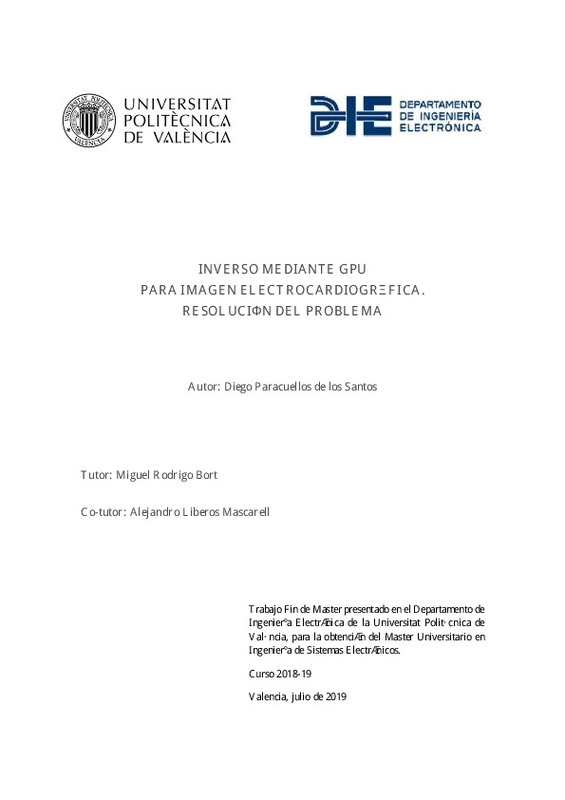JavaScript is disabled for your browser. Some features of this site may not work without it.
Buscar en RiuNet
Listar
Mi cuenta
Estadísticas
Ayuda RiuNet
Admin. UPV
Resolución del problema inverso mediante GPU para Imágen Electrocardiográfica
Mostrar el registro sencillo del ítem
Ficheros en el ítem
| dc.contributor.advisor | Rodrigo Bort, Miguel
|
es_ES |
| dc.contributor.advisor | Liberos Mascarell, Alejandro
|
es_ES |
| dc.contributor.author | Paracuellos de los Santos, Diego
|
es_ES |
| dc.date.accessioned | 2019-10-15T10:37:30Z | |
| dc.date.available | 2019-10-15T10:37:30Z | |
| dc.date.created | 2019-07-26 | es_ES |
| dc.date.issued | 2019-10-15 | es_ES |
| dc.identifier.uri | http://hdl.handle.net/10251/128429 | |
| dc.description.abstract | [ES] La Imagen Electrocardiográfica (ECGI) permite estimar los potenciales en la superficie epicárdica a partir de registros electrocardiográficos de superficie. Para poder realizar la reconstrucción de los potenciales epicárdicos es necesario disponer de la anatomía de la superficie del torso del paciente y la ubicación de los electrodos de registro sobre la superficie del torso, y junto con los potenciales registrados en el torso del paciente se resuelve el llamado problema inverso, basado en la regularización de Tikhonov de la matriz de trasferencia entre superficie cardiaca y del torso. La resolución de este problema inverso se basa en realizar la inversa de dicha matriz de transferencia con diferentes parámetros de regularización, y es computacionalmente muy costosa. Este problema hace que sea difícil a día de hoy introducir este método de diagnóstico en la práctica clínica. El objetivo del presente trabajo final de grado es proponer el uso de procesado paralelo en GPU, mediante lenguaje CUDA, para acelerar dicho proceso de cálculo. Hipótesis: Nuestra hipótesis es que, mediante la paralelización del proceso de cálculo de regularización, se puede disminuir de manera considerable el tiempo de procesado. Objetivos: Diseñar un algoritmo que permita paralelizar el problema inverso, a través de la paralelización del cálculo de la inversa de la matriz y del cálculo simultáneo de varias matrices. Tareas: T1.- Revisión bibliográfica del tema, para adquirir conocimientos básicos necesarios sobre problema inverso de la electrocardiografía y sobre problema inverso. T2.- Familiarización con el procedimiento actual de resolución del problema inverso en Matlab T3.- Propuesta de código de procesado en CUDA para la inversa de la matriz basado en librerías CuBlas T4.-. Adaptación del código de actual a la ejecución CUDA mediante pasarela con Matlab. T5.- Programación del cálculo de diferentes matrices de forma simultánea. T6.- Validación del proceso y algoritmos. T7.- Redacción de la memoria y preparación de la presentación. | es_ES |
| dc.description.abstract | [EN] The Electrocardiographic Imaging (ECGI) technique allows to estimate the electric potentials in the epicardial surface from electrocardiographic surface recordings. In order to perform the reconstruction of the epicardial potentials it is necessary to have the anatomy of the torso surface of the patient and the location of the recording electrodes on the torso surface, and together with the potentials registered in the torso of the patient the called inverse problem is solved, based on the Tikhonov regularization of the transference matrix between cardiac surface and torso. The resolution of this inverse problem is based on performing the inverse of said transfer matrix with different regularization parameters, and it is computationally very expensive. This problem makes it difficult today to introduce this diagnostic method in clinical practice. The aim of the present final degree project is to propose the use of parallel processing in GPU, using CUDA language, to accelerate this calculation process. Hypothesis: Our hypothesis is that, by means of the parallelization of the regularization calculation process, the processing time can be considerably reduced. Goals: Design an algorithm that allows to parallelize the inverse problem, through the parallelization of the calculation of the inverse of the matrix and the simultaneous calculation of several matrices. Chores: T1.- Bibliographic review of the subject, to acquire necessary basic knowledge about the inverse problem of the electrocardiography and about the inverse problem. T2.- Familiarization with the current procedure of solving the inverse problem in Matlab T3.- Proposal of processing code in CUDA for the inverse of the matrix based on libraries CuBlas T4.-. Adaptation of the current code to the CUDA execution by means of a gateway with Matlab. T5.- Programming the calculation of different matrices simultaneously. T6.- Validation of the process and algorithms. T7.- Writing of the memory and preparation of the presentation. | en_EN |
| dc.language | Español | es_ES |
| dc.publisher | Universitat Politècnica de València | es_ES |
| dc.rights | Reconocimiento (by) | es_ES |
| dc.subject | Problema Inverso | es_ES |
| dc.subject | Imágen Electrocardiográfica | es_ES |
| dc.subject | Procesado GPU | es_ES |
| dc.subject | Paralelizacion | es_ES |
| dc.subject | CUDA | es_ES |
| dc.subject | Inverse Problem | en_EN |
| dc.subject | Electrocardiographic Imaging | en_EN |
| dc.subject | GPU Processing | en_EN |
| dc.subject | Parallelization | en_EN |
| dc.subject.classification | TECNOLOGIA ELECTRONICA | es_ES |
| dc.subject.other | Máster Universitario en Ingeniería de los Sistemas Electrónicos-Màster Universitari en Enginyeria de Sistemes Electrònics | es_ES |
| dc.title | Resolución del problema inverso mediante GPU para Imágen Electrocardiográfica | es_ES |
| dc.type | Tesis de máster | es_ES |
| dc.rights.accessRights | Abierto | es_ES |
| dc.contributor.affiliation | Universitat Politècnica de València. Departamento de Ingeniería Electrónica - Departament d'Enginyeria Electrònica | es_ES |
| dc.description.bibliographicCitation | Paracuellos De Los Santos, D. (2019). Resolución del problema inverso mediante GPU para Imágen Electrocardiográfica. Universitat Politècnica de València. http://hdl.handle.net/10251/128429 | es_ES |
| dc.description.accrualMethod | TFGM | es_ES |
| dc.relation.pasarela | TFGM\112939 | es_ES |






